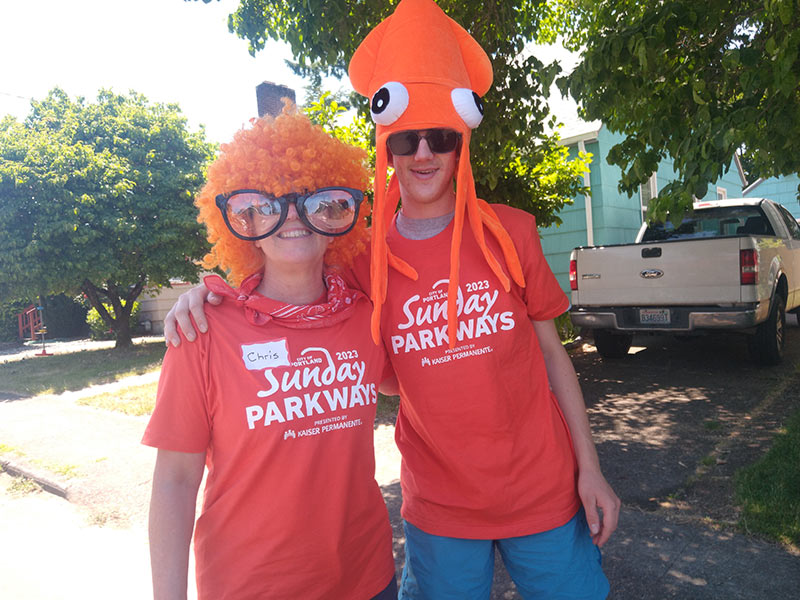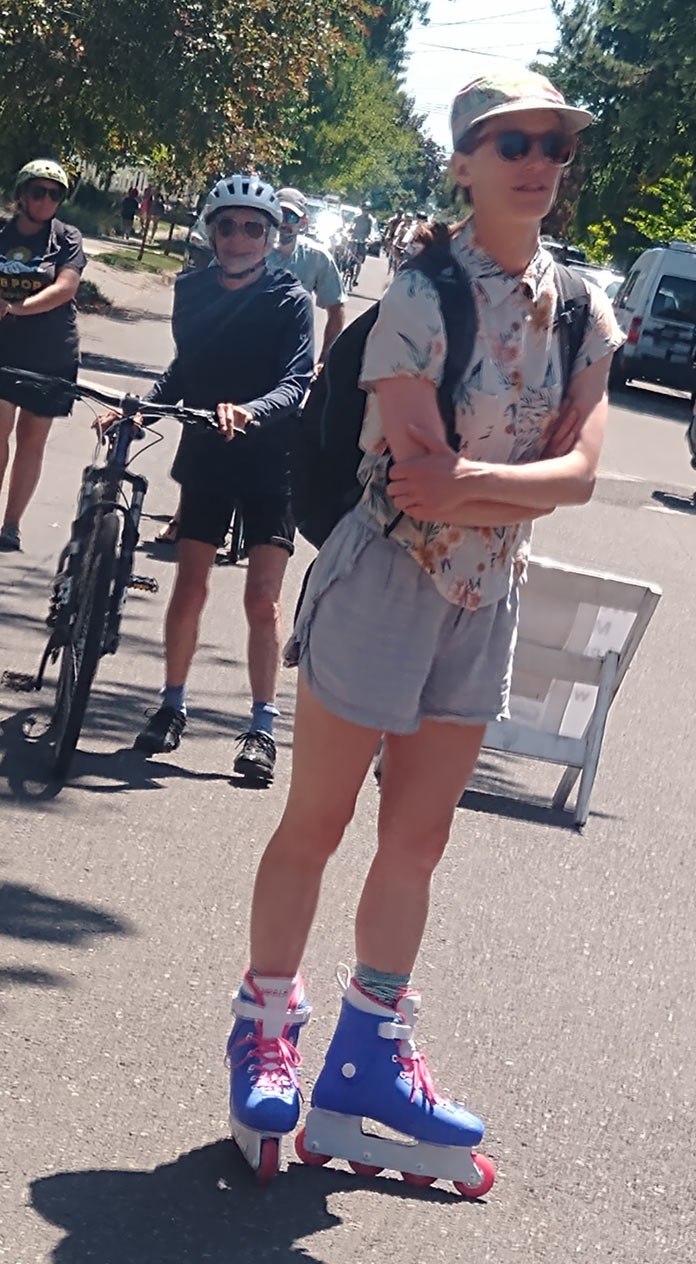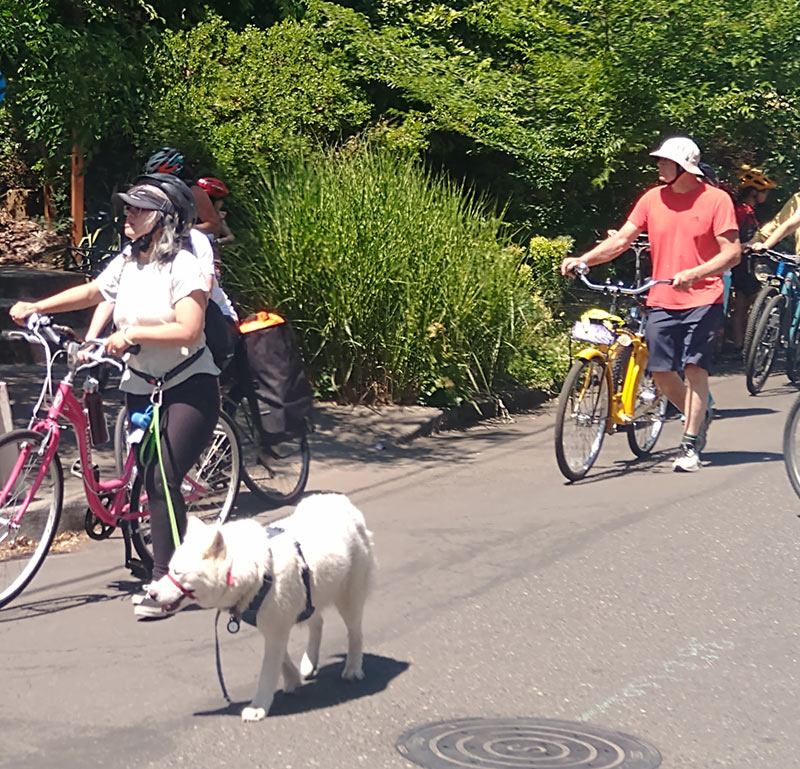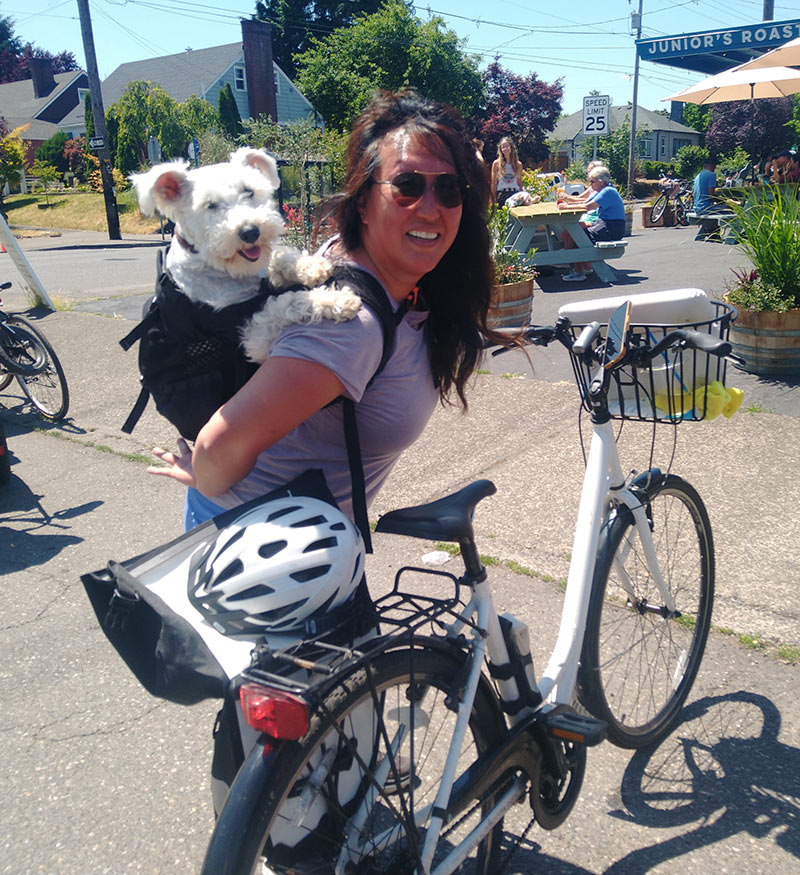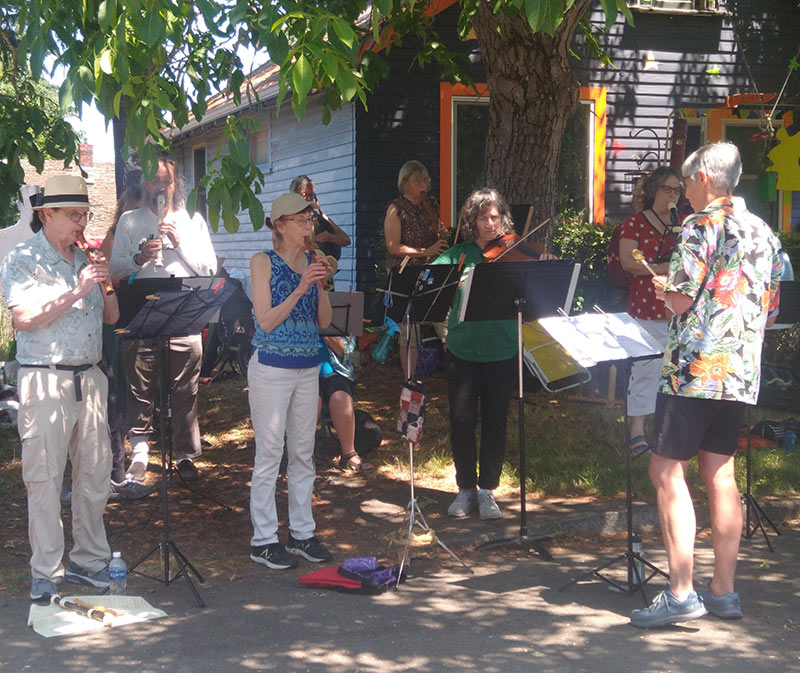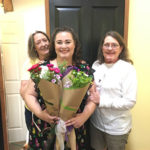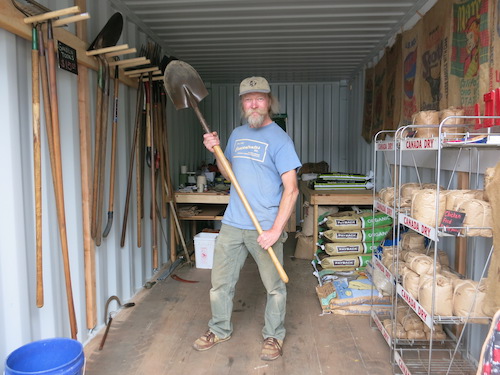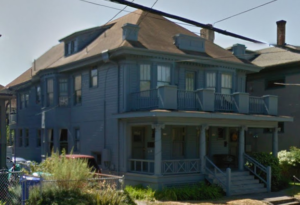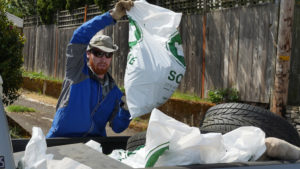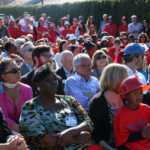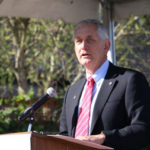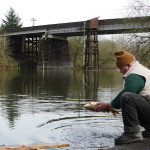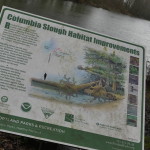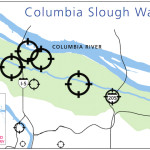33,000 people attended the Northeast Cully Sunday Parkways neighborhood bike ride presented by Kaiser Permanente on June 25th! Photos by Jordana Leeb
Archives
Black lives matter to shop, shoppers
By Ryan O’Connor
The owners of a Concordia neighborhood flower shop on Alberta Street know black lives matter. An artistic, handmade sign on the front door of their shop says so.
Beneath the words, “black lives matter,” Elie Wiesel is quoted. “Whenever & wherever human beings endure suffering and humiliation, take sides. Neutrality helps the oppressor never the victim. Silence encourages the tormentor, never the tormented.”
When news broke of the deaths of Alton Sterling and Philando Castile, two black men killed by police in Louisiana and Minnesota, respectively, shop owners Mary Anne Huseby, Pat Hutchins and Lily Hutchins said they were devastated.
They believe they have the privilege of not worrying about how their white skin might affect their interactions with police and others in authority. They agreed they could not remain silent.
Lily proposed making the black lives matter sign, and Pat suggested adding the Holocaust survivor’s quote. Lily said she worried briefly the sign might cut down on walk-in traffic.
“But we all feel really empowered by stating our beliefs so clearly on the front door,” she explained. Overall, reactions from neighbors and customers have been positive.
Customers and passers-by have taken notice. John Middleton, a Concordia resident and longtime customer who is black explained, “The sign shows that ignoring and keeping a silent voice through all oppression is not OK.”
John started doing business with Flowers in Flight for the quality of the artistry. He believes some people have negative reactions to the sign, and that Flowers in Flight’s decision to retain the sign despite possible negative reactions means to him the owners care about people of color.
Mary Anne and Pat are sisters who have lived in northeast Portland for about 30 years, and started their business in 1984. Lily is Pat’s daughter, who joined them at work in 2012.
They have a racially diverse family, so they are aware of the issues facing people of color in Portland. Concordia’s history of diversity and the challenges presented by gentrification propelled them to post their sign.
Although the women did not post the sign to increase business, John reported he takes note of any store that posts one.
“I try to find a reason to go into to that business,” he said. “It has a huge influence on where I go, and it makes me feel better about the people who go to that business.”
 Ryan O’Connor moved to Portland for college in 1997, and he and his family moved to the Concordia neighborhood a year ago. Most weekends, you can find them playing in Fernhill Park or walking to one of Concordia’s many excellent coffee shops or restaurants.
Ryan O’Connor moved to Portland for college in 1997, and he and his family moved to the Concordia neighborhood a year ago. Most weekends, you can find them playing in Fernhill Park or walking to one of Concordia’s many excellent coffee shops or restaurants.
Cully Farm Store offers urban farmers convenient option, access to market
By Susan Trabucco, CNA Media Team
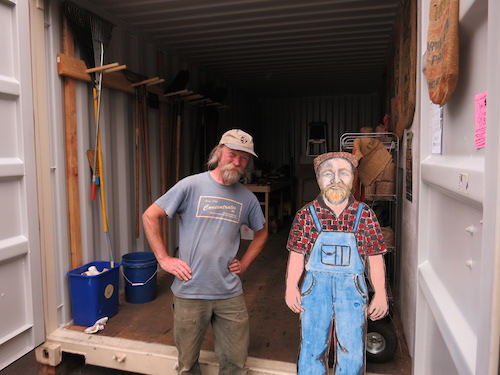
Urban farming is alive and well in NE Portland, and Cully resident Ted Snider’s new entrepreneurial pursuit aims to meet the needs of those who dig, plant, weed, feed and fertilize to grow food for their families, or those who grow and harvest to supply fresh produce to local farmers markets.
Snider recently opened Cully Farm Store from a shipping container that shares parking lot space with Roses Ice Cream on NE 42nd Avenue. From that small space, and additional canopied space behind Roses, Snider purveys used but reconditioned garden tools, supplies to satisfy chickens and their tenders; and organic soil amendments. Additionally, farmers from the surrounding neighborhoods provide vegetable starts for sale; Cully Farm Store offers these farmers an expanded market and ideally more sales.
“Cully Farm Store acts as a collaborative neighborhood outlet,” said Snider, who has farmed in Cully for nearly 10 years. Snider was inspired to launch his micro-store out of a desire to help people in their efforts to grow their own food.
“I want to provide the plants, feeds, and other items necessary to support and increase food growth in the neighborhood,” he said.
Snider said the Cully area was historically a food-growing area.
“There used to be two canneries in Cully,” said Snider. People would bring their extra corn or tomatoes to a cannery one day, and pick it up to pack it home the next day.”
As a provider of goods to urban farmers, Snider caters to those who choose not to drive or do not have a vehicle, packaging products in small quantities to allow shoppers on bicycles to carry items home easily.
“I’ve had customer walk their wheelbarrows over here and then wheel their goods back home,” he said.
Snider seems to have found his calling. He attended Reed College for a year out of high school, but found the idea of desk job to be unattractive, so he discontinued his formal education.
“I wanted to work with my hands,” Snider said with a smile.
Find Snider manning his post at the Cully Farm Store at 5011 NE 42nd Ave. from 10 a.m. to 6 p.m. Thursday through Sunday. To enter the shop, walk between Roses and the container that serves as the store, or enter via the Roses parking lot. For more information email cullyfarmstore@gmail.com or call Snider’s personal phone (503) 729-3508. A website, www.cullyfarmstore.com, is in the works.
Missing Middle Housing
By Garlynn Woodsong Chair, CNA LUTC
There’s a pretty hot topic being discussed now in Portland and in other cities across the nation. It’s Missing Middle Housing, a term coined only a few years ago, in 2012, by architect and urban designer Dan Parolek of Opticos Design in Berkeley, CA. The term refers to types of housing that are compatible with single-family homes in scale, but tend to provide more than one dwelling unit per lot, including:
- Townhomes
- Duplexes
- Triplexes
- Fourplexes
- Bungalow Courts
- Carriage Houses (Accessory Dwelling Units)
- Single-room Occupancies
- Townhome Courts
- Courtyard Apartments
- Small Multiplexes
- Live/work units
- Stacked Townhomes
These housing types can fill a much needed market gap, not just for young Millenials, but also for empty-nesters who are downsizing; elders wishing to age in communities; teachers, fire fighters, and the middle class; immigrants and others needing multi-generational housing; and families with children. The types all work regardless of tenure to provide both more affordable homeownership options as well as rental housing in smaller-format structures than the larger apartment buildings found on our main streets.
The demographics of Portlanders are changing. While the average number of people per home in the Metro region was 2.43 in 2010, it is projected to drop to 2.38 by 2030. For the average household size across the whole region to drop even this small of an amount (2.43 – 2.38 = 0.05 reduction in average people per household), the average people per home for new growth only will be 1.85.
This means increasing demand for smaller and more flexible housing, including these Missing Middle housing types. This means increasing demand for smaller and more flexible housing, including these Missing Middle housing types.
For more information, see www.portlandforeveryone.org or send an email.
Garlynn Woodsong is a Concordia resident and the Chair of the Concordia Neighborhood Association’s Land Use & Transportation Committee.
2nd Annual Spring Alley Clean Up and Revitalization
Story and photos by Carl Jameson
Concordia’s alleys are an underutilized community asset according to Garlynn Woodsong, Chair, CNA Land Use & Transportation Committee (LUTC) and cleaning them up is the first step toward their revitalization. To that end 30 volunteers, mostly students from Concordia University, fanned out over the 120 alleys in the Concordia neighborhood and picked up trash and other debris on Sat., April 16.
What they found wasn’t surprising. The alleys were littered with cardboard, paper, plastics and the occasional tire. Some of the alleys were blocked wit h mud, blackberry vines and laurel bushes making passage by impossible. “Once we pick up these alleys people will see this sort of neglected space where they can walk their dog, or go for a walk with their kids, or maybe imagine planting some flowers and improving the muddy surface with permeable pavers or just new load of gravel.” said Woodsong.
Alleys are a public right-of-way, but, like sidewalks, their maintenance is the responsibility of adjacent private property owners. Many were once used for car access to the garages in back of homes, but have since been abandoned. Woodsong said, “What we are really trying to do is inspire the adjacent private property owners to band together and start maintaining or improving this neglected public right of way.”
Concordia residents interested in alleys or any other issue related to land use and transportation are invited to attend the Concordia Neighborhood Association Land Use and Transportation Committee (CNA LUTC) meetings at 7p.m. on the third Wednesday of the month, in the Community Room in the SE corner of McMenamins Kennedy School. Click here to join the LUTC mailing list.
The new Faubion PK- 8/Concordia University building breaks ground under sunny skies
More than 400 students, educators, elected officials, and community members gathered on the warm, sunny morning of April 7 to break ground and celebrate the development of a signature new facility for education in Portland.
“This is how we turn hope into opportunity,” said City of Portland Mayor Charlie Hales.
The new building will combine Portland Public Schools’ Faubion School and the Concordia University College of Education. In addition, Trillium Family Services joins them in collaborating to create 3 to PhD® – a new model for education that aims to create safer, healthier and more educated communities.
Prior to the Groundbreaking Ceremony much construction has happened at the Faubion site. In February demolition crews took down the old building to make way for the new, and within a couple of weeks the buildings were gone. All scrap metals were recycled, thousands of bricks will be reused and all the asphalt and concrete are being recycled and reused on site. At the end of February construction began with foundations for the new building being poured. As March came to an end more foundations were prepared for pouring and seismic sheer walls began to rise from the ground.
Moss studies provide map of Portland’s toxic pollution
Lately the news that for decades two Portland glass companies discharged the toxic chemicals cadmium, arsenic and chromium into the city’s air have filled the media with stories of citizen outrage. State, county and local governments and community groups have suddenly demanded action from the Oregon Department of Environmental Quality (DEQ).
Less talked about is that the same toxic chemicals found in Portland’s air eventually make it into its rivers, lakes and wetlands through the process known as atmospheric deposition (or rain) and become an ingredient in a toxic stew. Local waterways flow with legacy pollutants such as PCB’s and DDT from dirty industrial sites, emerging contaminants like pharmaceuticals and flame retardants, pesticides, and heavy metals like mercury and arsenic from coal fired power plants.
The Columbia Slough is one such locally-affected waterway. The Columbia Slough basin extends from Blue Lake and flows toward Kelly Point Park where it meets the confluence of Willamette and the Columbia River. The Concordia neighborhood is contained in the slough’s watershed.
Today the slough is cleaner than it has been for over a century. The biggest change came in 2000, when the city’s sewers stopped dumping raw sewage and untreated wastewater into the slough during heavy rain storms. Portland’s Department of Environmental Services works with Oregon DEQ to investigate and eliminate sources of fish contamination in the Columbia Slough. They also partner with The Columbia Slough Watershed Council on habitat restoration. There’s a fish consumption advisory, however, on the Columbia Slough and it’s been that way for years.
Pregnant women and children are especially vulnerable to the toxins in the slough’s resident fish. Many Portlanders know that local waters are polluted and they wouldn’t dare eat fish from the Columbia Slough. Other community members, warning or not, have little choice in the matter. The houseless and poor often supplement their diet by eating the most toxic of fish: carp, bass and catfish.
In 2012, Lorri Epstein the Water Quality Director at Columbia Riverkeeper, a non-profit dedicated to protecting the Columbia River, took a catfish from the slough to the lab. The results were stunning. The catfish contained PCBs 27,000 times the Environmental Protection Agency (EPA) limit for unrestricted consumption and flame retardants. A carp from nearby Vancouver Lake tested in 2014 contained PCBs 30 times the EPA limit, mercury 3.5 times the EPA limit, flame retardants and other heavy metals.
“Fish advisories are not the answer. We need to clean up the river and stop toxic pollution from entering our river so that people can eat fish without the fear of getting sick,” said Epstein.
The Portland city council passed a resolution in March 2016 to sue the Monsanto Company for contaminating Portland waterways with PCBs from the 1930-70’s. There are still multiple point sources of arsenic and lead near the Columbia Slough according to recent moss studies. The Oregon Department of Environmental Quality used the studies to pinpoint the glass companies as sources of toxic air pollution. The moss studies could also provide the map the DEQ needs to locate the owners of toxic water sources in the Columbia Slough watershed.

